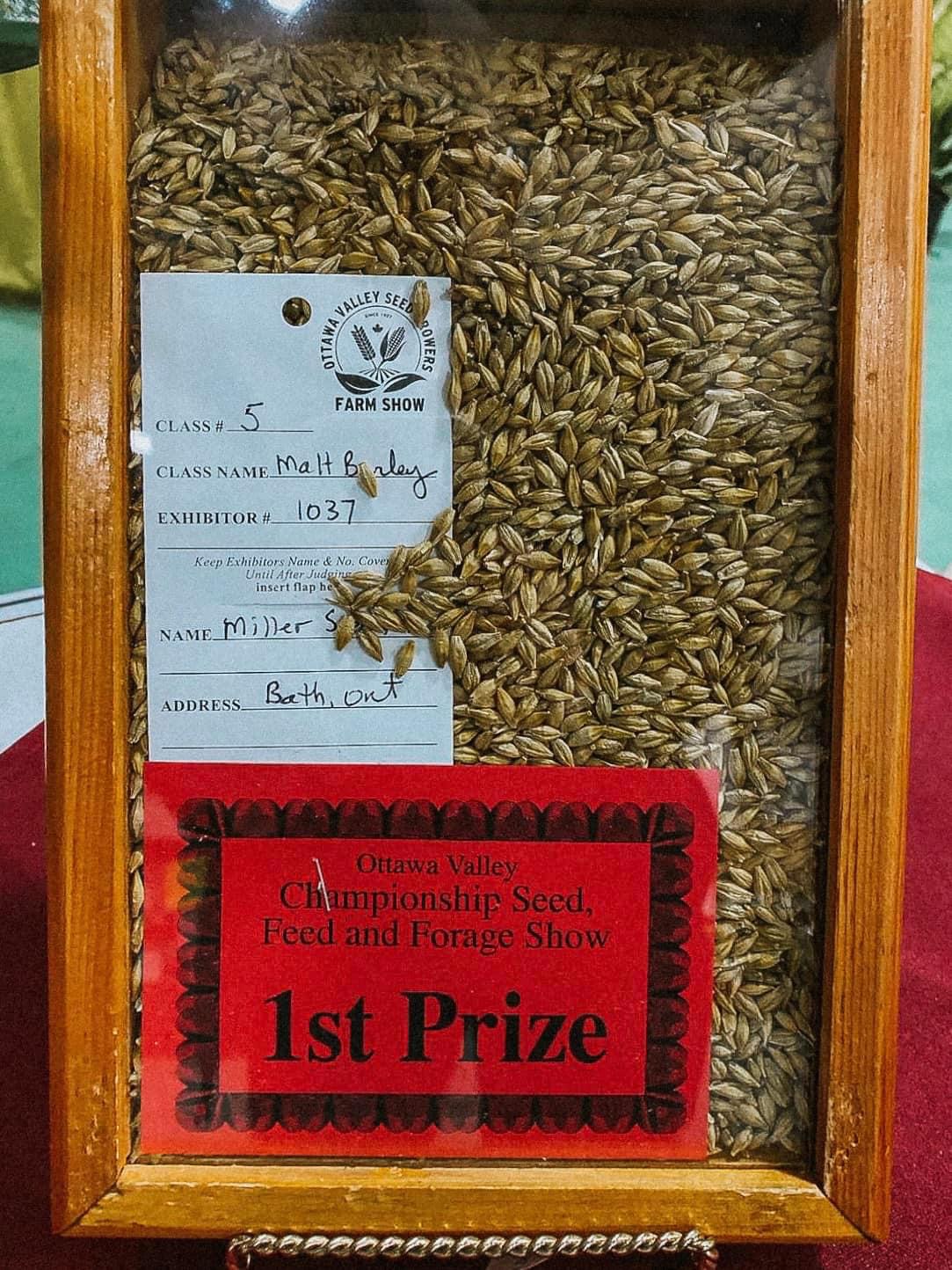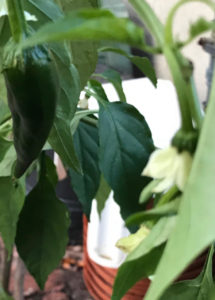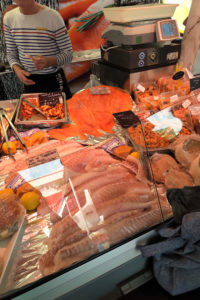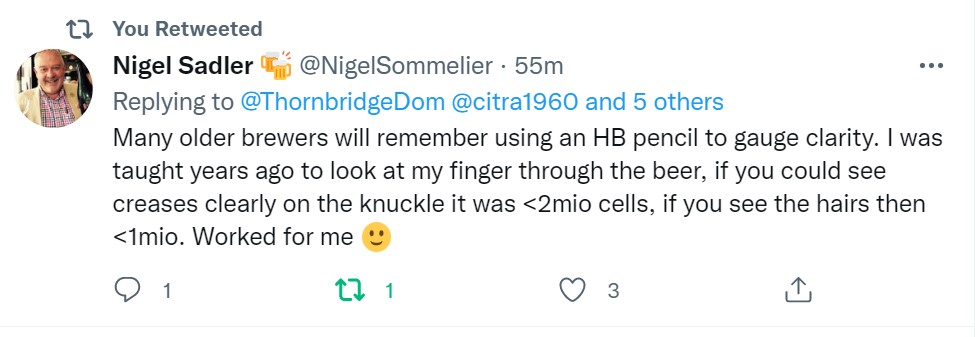 Well, that wasn’t too bad of a winter, was it. Was it? A time for reflection and relaxation. And winning prizes apparently. This was posted on the Facebook page for my near neighbours MacKinnon Brother’s Brewing who explained how their farm and brewery operation took the gold cup… or the blue ribbon… or red the sticker:
Well, that wasn’t too bad of a winter, was it. Was it? A time for reflection and relaxation. And winning prizes apparently. This was posted on the Facebook page for my near neighbours MacKinnon Brother’s Brewing who explained how their farm and brewery operation took the gold cup… or the blue ribbon… or red the sticker:
First place in the Malt Barley category at the Ottawa Valley farm show! The farming side of the operation, Miller Seed Farm, grows certified seed on 1300 acres. There is a high amount of diversity, with a crop rotation including wheat, oats, barley (feed and malting), soybeans, and corn.
Give you great level of confidence when your brewer is also the farmer. You know, it’s been a good week for photos. Perhaps a bit of an album as a keepsake is in order. Here are a few of the ones that caught my eye:
From left to right, that’s The Beer Nut on the road looking at the wooden vats at Boon, the packing line at Crisp Maltings where its “100% grown, malted and packaged in Scotland. 90% of our farms are within 50 miles” as well as The Old Wellington in Manchester, England established in 1552 on the move in 1971:
…raised on timber pillars and a stone base, our historic building was lifted and moved down the road to where you see it today! Crazy stuff.
You know, I never know what to think about the taxation issue. Folk need to fund the services we uses after all – as examples of its absence show, like in place where the word “austerity” is thrown about as code for taking the burden off all of those who can best afford it. That being said, this pending increase in Canadian federal excise tax does, however, seem to be a levy which has an unequal effect:
The 6.3-per-cent increase is the biggest that Christine Comeau, executive director of the Canadian Craft Brewers Association, has seen, she said. The group wants Ottawa to reconsider the way the tax is levied. The national body said Canada is home to more than 1,100 craft breweries that account for more than 21,000 jobs. The association said the vast majority of those breweries are less than five years old, and most are not yet profitable.
Now, the article states that excise duties are also imposed on spirits, wine, tobacco, cannabis and vaping products suggesting it is just sin related but forms of such national levies are also imposed on insurance premiums, automotive air conditioners and, my favourite, luxuries. By the way, the UK seems to have issued an inter-galectic scale offset.
What else has been going on? Now that you are up on your Canadian federal excise categories… well, The Beer Nut found a way to discuss an Abbey NEIPA this week:
Like any right-thinking drinker of Belgian beer, I consider Troubadour Magma to be one of the greats, taking strong influence from powerhouse American IPA and giving it just a little bit of a classy Belgian twist. I’m not the only one who thinks so highly of it, as evidenced by the brewery’s insistence on releasing brand extensions. So far, only the Brettanomyces-spiked one has been worthy of the name, in my estimation, but here’s another one to try: the inevitable Magma NEIPA.
Spoiler: he likes. [I still think “yikes!” myself but that’s just me.]
Ron is in Brazil… again. Or he’s back from Brazil… again. And sharing his breakfasts. But more importantly, he guided me to this excellent article on koelships by Marta Holley-Paquette of the Beer of SMOD:
A growing list of American and now British craft breweries have since installed these relics. But to properly understand the cooler, we need to go back in time to when they were a logical part of a typical brewhouse. Then we will follow them into traditional breweries who still use them, and perhaps even discover why they went away. In the early days of industrial brewing, the post boil, pre-fermentation period must have been agonizingly long. Cooling down from the boil (100C) to fermentation temperatures in the teens likely required an overnight stand. Not ideal when you’re dealing with a fragile liquid such as unfermented wort. It’s the perfect place for all sorts of microscopic nasties to make their new home, fouling the flavor and longer-term stability of your beer.
Speaking of the supply chain… no, we weren’t… but we are now… it’s not the main topic of conversation but the movement of cash can be as problematic is the reciprocal goods, as Lucy Britner reported in Drinks Retailing:
When the pandemic hit, the pair pivoted to online beer sales and a subscription club. The founders were featured in many news articles in summer 2022, heralding their “£10 million beer company”. But relationships with the trade have soured, as several brewers raised concerns over unpaid bills. Yeastie Boys founder Stu McKinlay said his business is owed around £17,000 from a £27,000 order going back to 2021. “Their last order from us was in late 2021, previous to which they’d purchased a couple of times and cleared all their debts,” he told Drinks Retailing. “They ordered £27,000 worth of stock and took many months of hassling them – plus a letter of demand – to make any payment on that. They only paid £5,000 and then disappeared again.”
Jeff reported on another effect of the pandemic – changed drinking habits:
Those shifts have had profound effects on our cities. Downtowns, once hubs for office work, emptied out and many never really refilled. That meant workers quit pouring into commercial districts, so restaurants and dry cleaners and shops started closing. And pubs… Entire activities we once enjoyed are withering. We don’t go out to movies anymore; we stream content on our devices. We don’t go to concerts as much anymore; we stream music on our phones. And, highly relevant to the beer world, we just don’t go out to drink as much anymore.
Beer flavoured popsicles? Why bother? Speaking of which, it is a sad state of affairs when Craft Beer & Brewing has to explain something that I assumed was learned at the first week of brewers’ school – you can make flavours in beer without chucking in those E-Z gallons of syrup:
Fruit was one of the first things that craft beer used to differentiate itself from mass-market beer. (Remember the ubiquity of fruited wheat beers in the late ’90s and early ’00s?) Yet it remains something of a mysterious ingredient for many brewers. Lost in much of the debate, however—about extracts versus real fruit, puréed versus macerated versus whole, adding fruit in the boil versus the fermentor, and so on—is this question: Do you actually need that fruit in the first place? Now, I’m not passive-aggressively suggesting that you shouldn’t brew with fruit. Nor am I suggesting that you should avoid real fruit and start hitting the chemical extracts.
So… I am. I am suggesting that. Just for the record, don’t we all agree that you should be able to brew a beer well without adjuncts before you use adjuncts if you are going to, you know, take pride in your product? And umm… see that loss of interest in craft beer over the last while? Guess why. Bed? Pooped in.
Err… isn’t “Manifest Destinty“** one of those slogans that should be, you know, ditched because of its racist colonial implucations? Speaking of which, is there any less appealing form of beer story than the semi-annual “ten people I know pull ten breweries you will never hear of again out of their arses” story? Comes in St. Patrick’s Day editions, too. Maybe it’s the haunt spoiler construct. Or maybe the recirculated Proust analogy laced post… maybe…
Alistair at Fuggled found time to wander towards the Rio Grande… I think… and sent a dispatch from Texas where he found his Czech-xas bliss:
I have to admit that I was thrown off by the bartender asking me if I wanted the beer “crispy or sweet”, but she was talking about the style of pour that I wanted, hladinka or šnyt. As you can see I agree with Karel Čapek that a šnyt is “at least something more than nothing”, and so had a classic hladinka. Pilz pours a lovely light golden, is as clear as a bell, and that wet creamy foam just kind of sat there, at least until I slurped a good deal of it off. Up to this point, the only Pilz I had had was canned, but fresh at source on tap is basically as good as beer gets.
I have been gathering in more of the good stuff, including the newest entry to the list of listenables and good reads down below, Will Hawkes’ London Beer City, where this month we read:
I sit by the window and stare towards Peckham Rye itself. This is a great London view: red buses and people of all backgrounds, movement and life and colour. A man on rollerblades, tugged by a staffie, races past on his way up Rye Lane. Inside, the swearing man admonishes his friend: “Fucking ‘ell Jude, that was 40 years ago!”40 years ago, Only Fools and Horses was in its pomp – and this pub was called The Morning Star. It existed under that name for more than a century, featuring in Muriel Spark’s Ballad of Peckham Rye, before it became The Nag’s Head perhaps 20 years ago, according to this account. It was named after the pub in Only Fools and Horses, a whimsical evocation of the perfect working-class South London pub.
And Ben Johnson‘s podcast is back, by the way. Very focused on the Ontario scene. Even the southwestern Ontario scene. But his stress dream about service jobs decades ago are a good topic this week.
There. Done. Consider Mastodon. Here’s your newbie cheat sheet:
Stan Hieronymus | The Man!
Boak & Bailey | The B² experience
Katie Mather | Shiny Biscuit and Corto
David Jesudason | “Desi Pubs” (2023) author
Ron Pattinson | The RonAlongAThon Himself
Al Reece AKA Velky Al | Fuggled
Jennifer Jordan | US hops historian
Alan McLeod | A Good Beer Blog (… me…)
Andreas Krennmair | Vienna beer and lager historian
Beer Ladies Podcast | Lisa Grimm and colleagues
Jay Brooks | Brookston Beer Bulletin
Joe Stange | Belgian beer expert, beer magazine editor
Cider Bar | Barry makes Kertelreiter cider
Laura Hadland | CAMRA historian and beer writer
Brian Alberts | US beer historian
Jon Abernathy | The Beer Site
Maureen Ogle | US Beer Historian
Lars Garshol | Norwegian Beer Historian and Kveik Hunter
James Beeson | Beeson on Beer
Carla Jean | MAINER!!!
Thandi Guilherme | Beer Ladies Podcast Co-host
Lisa Grimm | Beer Ladies Podcast Co-host
Rob Talksbeer | Podcaster and Youtuber
Anthony Gladman | UK Drinks Writer
Jeff Alworth | Manna Of Beervana
Northwest Beer Guide | Fairly self explanatory… but not NW Latvia…
Evan Rail | Prague based GBH editor, freelance writer, NYT etc.
Todd Alström | 50% of the Alströms
Jacob Berg | Beer talking librarian
Anyone else? And check the blogs, podcasts and newsletters including more weekly recommendations from Boak and Bailey every Saturday and maybe from Stan at his spot on those Mondays but, you know, he writes bits and bobs when he can… like this! Get your emailed issue of Episodes of my Pub Life by David Jesudason every Friday. Once a month, WIll Hawkes issues his London Beer City newsletter and do sign up for Katie’s wonderful newsletter, The Gulp, too. Ben’s Beer and Badword is back! And check out the Atlantic Canada Beer Blog‘s weekly roundup. There is new reading at The Glass. Any more? Yes! Check to see the highly recommended Beer Ladies Podcast. And the long standing Beervana podcast . There is the Boys Are From Märzen podcast too and check out the travel vids at Ontario’s own A Quick Beer. There is more from DaftAboutCraft‘s podcast, too. Still gearing up, the recently revived All About Beer has introduced a podcast, too even if it’s a bit trade. There’s also The Perfect Pour. Plus follow the venerable Full Pint podcast. And the Craft Beer Channel this week on Youtube. And remember BeerEdge, too, and The Moon Under Water… if you have $10 a month for this sort of thing… I don’t. Pete Brown’s costs a fifth of that. There was also the Beer O’clock Show but that was gone after a ten year run but returned renewed and here is the link!*
*In case you don’t know, it’s pretty much the North American version of Lebensraum.
**And finally the list of the departed newsletters and podcasts or those in purgatory. Looks like both Brewsround and Cabin Fever died in 2020, . We appreciate that the OCBG Podcast is on a very quiet schedule these days – but it’s been there now and again. The Fizz died in 2019. Ben has had his own podcast, Beer and Badword (Ed.: …notice of revival of which has been given… still not on the radio dial…) Plus Fermentation Radio with Emma Inch seems done and the AfroBeerChick podcast is gone as well! The Fingers Podcast packed it in citing, umm, lack of success… as might have been anticipated, honestly. Did they suffer a common fate? Who knows?













 My own tiny special reserve, illustrated to the right as Stan himself would want, has been
My own tiny special reserve, illustrated to the right as Stan himself would want, has been  Finally,
Finally, 

 Long time pal of this here blog and fellow Scot abroad Alistair Reese of
Long time pal of this here blog and fellow Scot abroad Alistair Reese of 




